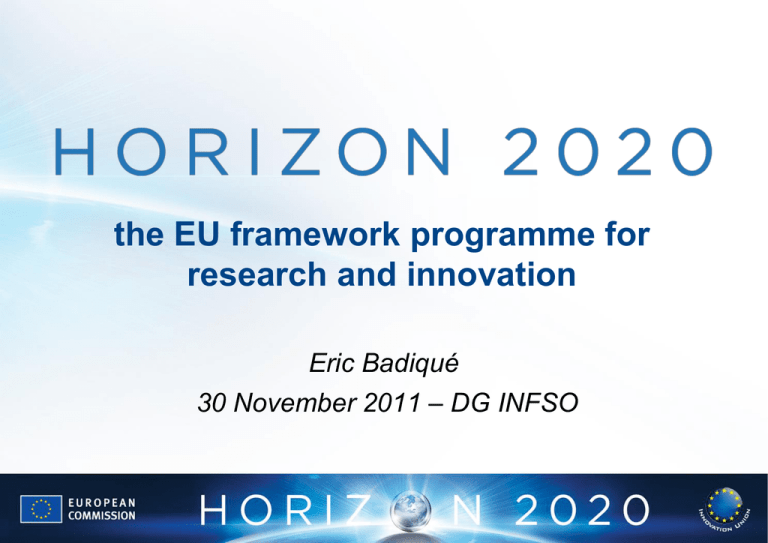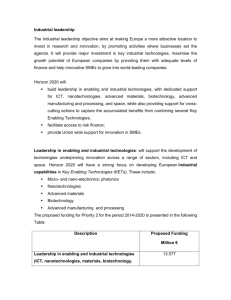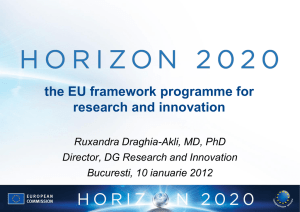Horizon 2020
advertisement

the EU framework programme for research and innovation Eric Badiqué 30 November 2011 – DG INFSO The Multiannual Financial Framework 2014-2020: Commission’s proposals of 29 June 2011 1. Smart & inclusive growth (€491bn) Education, Connecting Cohesion Youth, Sport Europe Competitive Business SMEs Horizon 2020 2. Sustainable growth, natural resources (€383bn) 3. Security and citizenship (€18.5bn) 4. Global Europe (€70bn) 5. Administration (€62.6bn) Total: € 1,025bn Horizon 2020 • Commission proposal for a 80 billion euro research and innovation funding programme (2014-20) • Part of proposals for next EU budget, complementing Structural Funds, education, etc. • A core part of Europe 2020, Innovation Union & European Research Area: – Responding to the economic crisis to invest in future jobs and growth – Addressing peoples’ concerns about their livelihoods, safety and environment. – Strengthening the EU’s global position in research, innovation and technology What’s new? • A single programme bringing together three separate programmes/initiatives (FP7, CIP, EIT) • More innovation, from research to retail, all forms of innovation • Focus on societal challenges facing EU society, e.g. health, clean energy and transport • Simplified access, for all companies, universities, institutes in all EU countries and beyond. Three priorities: 1 Excellent science 2 Industrial leadership 3 Societal challenges Horizon 2020 – Objectives and structure Europe 2020 priorities European Research Area International cooperation Shared objectives and principles ICT ICT ICT ICT ICT Tackling Societal Challenges Health, demographic change and wellbeing Food security, sustainable agriculture and the bio-based economy Secure, clean and efficient energy Smart, green and integrated transport Climate action, resource efficiency and raw materials Inclusive, innovative and secure societies EIT JRC Simplified access Creating Industrial Leadership and Competitive Frameworks Leadership in enabling and industrial technologies ICT ICT Nanotech., Materials, Manuf. and Processing Biotechnology Space Access to risk finance Innovation in SMEs Excellence in the Science Base Frontier research (ERC) Future and Emerging Technologies (FET) Skills and career development (Marie Curie) Research infrastructures ICT ICT Common rules, toolkit of funding schemes Dissemination & knowledge tranfer Priority 1 Excellent science Why: • World class science is the foundation of tomorrow’s technologies, jobs and wellbeing • Europe needs to develop, attract and retain research talent • Researchers need access to the best infrastructures Proposed funding (million euro, 2014-20) European Research Council 13 268 Frontier research by the best individual teams Future and Emerging Technologies 3 100 Collaborative research to open new fields of innovation Marie Curie actions 5 752 Opportunities for training and career development Research infrastructures (including e-infrastructure) 2 478 Ensuring access to world-class facilities ICT in Science - Future and Emerging Technologies; e-Infrastructures FET Open: fostering novel ideas Collaborative research for embryonic, high risk visionary science and technology FET Proactive Nurturing emerging themes and communities FET Flagships Tackling grand interdisciplinary science and technology challenges E-Infrastructures Integration and access to national research infrastructures; development, deployment and operation of e-Infrastructures Priority 2 Industrial leadership Why: • Europe needs more innovative SMEs to create growth and jobs • Strategic investments in key technologies (e.g. advanced manufacturing, micro-electronics) underpin innovation across existing and emerging sectors • Europe needs to attract more private investment in research and innovation Proposed funding (million euro, 2014-20) Leadership in enabling and industrial technologies (ICT, nanotechnologies, materials, 13 781 biotechnology, manufacturing, space) Access to risk finance 3 538 Leveraging private finance and venture capital for research and innovation Innovation in SMEs Fostering all forms of innovation in all types of SMEs 619 ICT in Industrial Leadership (I) 1. Components and systems Smart embedded components and systems, micro-nano-bio systems, organic electronics, large area integration, technologies for IoT, systems of systems and complex system engineering 2. Next generation computing Processor and system architecture, interconnect and data localisation technologies, cloud computing, parallel computing and simulation software 3. Future Internet Networks, software and services, cyber security, privacy and trust, wireless communication and all optical networks, immersive interactive multimedia and connected enterprise ICT in Leadership (II) 4. Content technologies and information management Technologies for language, learning, interaction, digital preservation, content access and analytics; advanced data mining, machine learning, statistical analysis and visual computing 5. Advanced interfaces and robots Service robotics, cognitive systems, advanced interfaces, smart spaces and sentient machines 6. Key Enabling Technologies: Micro- nano-electronics and photonics Design, advanced processes, pilot lines for fabrication, related production technologies and demonstration actions to validate technology developments and innovative business models Priority 3 Societal challenges Why: • EU policy objectives (climate, environment, energy, transport etc) cannot be achieved without innovation • Breakthrough solutions come from multi-disciplinary collaborations, including social sciences & humanities • Promising solutions need to be tested, demonstrated and scaled up Proposed funding (million euro, 2014-20) Health, demographic change and wellbeing 8 033 Food security, sustainable agriculture, marine and maritime resources & the bioeconomy Secure, clean and efficient energy* 4 152 Smart, green and integrated transport 6 802 Climate action, resource efficiency and raw materials 3 160 Inclusive, innovative and secure societies 3 819 5 782 *Additional €1 050m for nuclear safety and security from the Euratom Treaty activities (2014-18). Does not include ITER. ICT in societal challenges (I) – Health, demographic change & wellbeing; • – Secure, clean and efficient energy; • – e-health, self management of health, improved diagnostics, improved surveillance, health data collection, active ageing, assisted living; Smart cities; Energy efficient buildings; smart electricity grids; smart metering; Smart, green and integrated transport; • Smart transport equipment, infrastructures and services; innovative transport management systems; safety aspects ICT in societal challenges (II) – Climate action, resource efficiency and raw materials • – ICT for increased resource efficiency; earth observation and monitoring Inclusive, innovative and secure societies • Digital inclusion; social innovation platforms; e-government services; e-skills and e-learning; e-culture; cyber security; ensuring privacy and protection of human rights on-line Role of the EIT and JRC in Horizon 2020 Three priorities to be supported by: European Institute of Innovation and Technology (EIT) Combining research, innovation & training in Knowledge and Innovation Communities 1 360 + 1 440* Joint Research Centre (JRC)** 1 961 Providing a robust, evidence base for EU policies * Second tranche pro rata from LEIT and Societal challenges (subject to review) **Additional €724 m for the JRC to be funded from the Euratom Treaty activities Rules for Participation: what’s new? (1) 1. A SINGLE SET OF RULES Adapted for the whole research and innovation cycle Covering all research programmes and funding bodies Aligned to the Financial Regulation, coherent with other new EU Programmes. 2. ONE PROJECT - ONE FUNDING RATE. Maximum of 100% of direct costs (except for actions close to market, where a 70% maximum will apply) Indirect eligible costs: a flat rate of 20% of direct eligible costs 3. SIMPLE EVALUATION CRITERIA • Excellence – Impact - Implementation (Excellence only, for the ERC) 4. NEW FORMS OF FUNDING aimed at innovation: pre-commercial procurement, inducement prizes, dedicated loan and equity instruments. 5. INTERNATIONAL PARTICIPATION: facilitated but better protecting EU interests. Rules for Participation: what’s new? (2) 6. SIMPLER RULES FOR GRANTS: broader acceptance of participants accounting practices for direct costs, flat rate for indirect costs, no time-sheets for personnel working full time on a project, possibility of output-based grants. 7. FEWER, BETTER TARGETED CONTROLS AND AUDITS Lowest possible level of requirements for submission of audit certificates without undermining sound financial management; Audit strategy focused on risk and fraud prevention. 8. MORE COHERENT RULES ON INTELLECTUAL PROPERTY Balance between legal security and flexibility; Tailor-made IPR provisions for new forms of funding; A new emphasis on open access to research publications. Beyond the Rules: further simplified provisions in the Grant Agreement and implementing procedures to facilitate access to Horizon 2020 (eg. common IT platform). Next steps From 30/11: Parliament and Council negotiations on the basis of the Commission proposals Ongoing: Parliament and Council negotiations on EU budget 2014-20 (including overall budget for Horizon 2020) Mid 2012: Final calls under 7th Framework Programme for Research to bridge gap towards Horizon 2020 By end 2013: Adoption of legislative acts by Parliament and Council on Horizon 2020 1/1/2014: Horizon 2020 starts; launch of first calls Thank you for your attention! Find out more: www.ec.europa.eu/research/horizon2020








